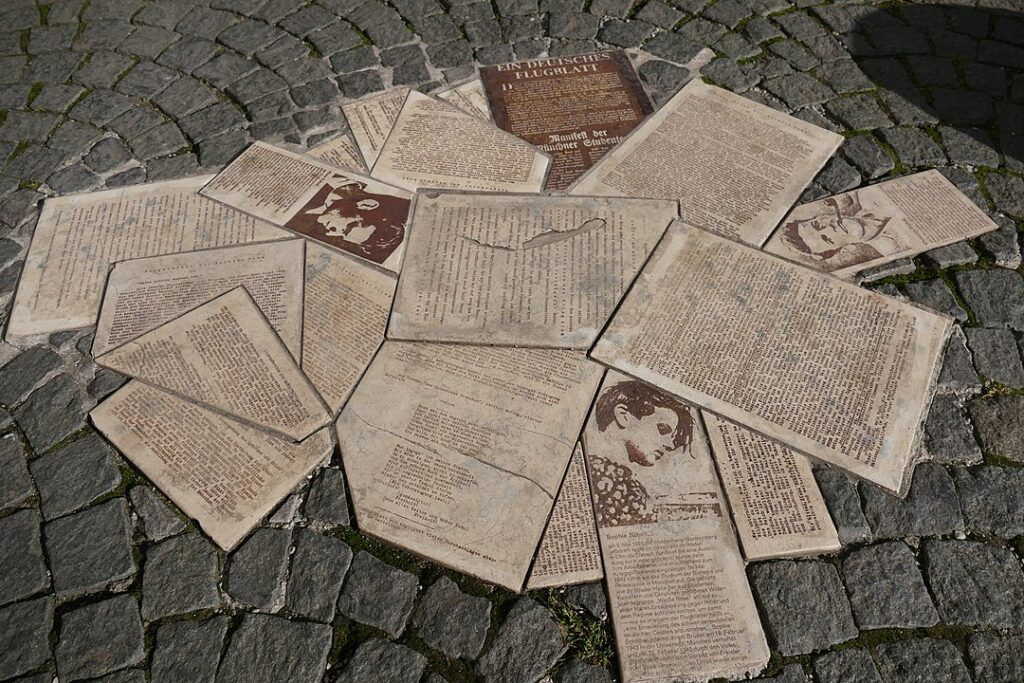As someone who grew up in a cookie-cutter American suburb, I am surprised again and again to discover secrets of buildings in Munich whose histories I thought I knew.
Walking past Munich’s Bayerischer Hof Hotel on the way to a book reading, I stop to look at a brass plate on the pavement, shaped like the outline of a body in a crumpled position, as in a crime scene. This is where Kurt Eisner, the first president of the post-WWI Bavarian parliament, was shot on his way to parliament to resign. This governing body, the so-called Münchner Räterepublik (Munich Republic of Councils), arose from the chaos of the November Revolution that came on the heels of WWI in Germany, turmoil that eventually resulted in the rise of the Weimar Republic. Many people now don’t even know that this republic existed, probably because it only lasted about a month.
Read more: The 100 meters between fascism and democracy in MunichI have walked past this memorial many times. Each time, I wonder why Eisner chose this route, considering that the parliament is more easily reached on a different street. Or so I thought.
The venue where I am headed, the Ludwig Maximilian University (LMU), is an integral part of the book being presented. It is the latest work by Ian McEwan, Lessons, which includes characters involved in the Weisse Rose movement that met its end right here at this university. Through an odd twist of fate, not only did the university figure in the early years of the Nazi regime, it was also a witness to Germany’s return to democracy.
To get to the auditorium where the reading will be held, I pass through the magnificent neoclassic-style atrium of the LMU, its broad stairways flanked by marble statues. Its beauty belies the tragedy that occurred here in 1943. A brother and sister, Hans and Sophie Scholl, members of the anti-Nazi movement Weisse Rose (the White Rose), distributed anti-government leaflets here. They had often done this in the past, but on this day, Sophie had extras and decided to simply throw them off the balustrade. The university locksmith spotted her and turned both her and her brother in to the authorities. Following a brief mock trial, they were both executed. The story of their clandestine activities and betrayal is retold in an award-winning movie. The half-circle plaza in front of the university, the Geschwister-Scholl-Platz, is named after them.
The Weisse Rose movement is well known in Munich. The Scholl siblings are local heroes, and their memory offers at least some consolation to the city which facilitated Hitler’s rise to power. When you walk along the Ludwigstrasse past the university, you can’t help but notice the name of this plaza and if you look more closely, you will also see a memorial to the Scholls and the movement they founded.
But while the atrium of the LMU offers a grim reminder of fascism, just down the hallway is the Grosse Aula, the large hall, where today’s reading is taking place. This stunning auditorium has a more optimistic story to tell. A huge mosaic framed with glittering gold stones features an assembly of Greek gods and columns that look down over the speaker’s podium, giving the audience something to look at while still paying attention. Listening to the Vice-President’s opening speech, I am startled to learn of the history of the very auditorium where we are sitting.
This room was the site of the first meeting of the Bavarian Parliament following WWI.
Bavarian Parliament? This is confusing. I know that this is located just two kilometers across town in the stately yellow building called the Maximilaneum. I immediately jump to the conclusion that the building had been destroyed in the war, like so much of Munich, obliging legislators to find another venue. But a quick google search reveals that the building, which was originally the site of a foundation started by its namesake, King Maximilian II, was hardly damaged.
My amateur history detective instinct kicks in.
Digging slightly deeper, I solve the conundrum. The original Bavarian parliament was at a different location altogether, at Prannerstrasse 20. And this building was completely obliterated in WWII; no trace of it remains. It was located at the back of the Bayerischer Hof Hotel, which is today the site of the annual Munich Security Conference. How fitting that this meeting of minds in search of world peace should be sandwiched between the sites of an assassination and a destroyed parliament, testaments to Bavaria’s failed attempts at democracy over 100 years ago.
Now it makes sense why Kurt Eisner was gunned down right next to the Bayerischer Hof Hotel. He wasn’t on his way to the current-day parliament in the Maximilianeum, but to the original parliament, just on the other side of the hotel. He was only some 50 paces away.
Just 100 meters separate the atrium of the LMU university and the Grosse Aula of this same building. The atrium bore witness to the arrest of Sophie and Hans Scholl, putting an end to their anti-Nazi movement, while the Grosse Aula is where the first post-WWI meeting of the Bavarian parliament was held.
So within a radius of just under two kilometers, the president of the parliament was assassinated, the parliament itself was obliterated by bombs in WWII, a secret anti-Nazi movement was quashed, a new parliament was launched under the watchful mosaic eyes of Greek gods, and finally, across the Isar River in the Maximilaneum, the current parliament found its new home. It is worth remembering the high price paid by previous generations for democracy when strolling down the present-day peaceful streets of Munich.
Brenda Arnold
Also interesting:
Hot wine and cold toes
The 37 Days of Christmas
Think digital technology is a cure-all? Don’t bet your life on it
